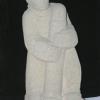stone
|
A set of five ground stone native tools: a small mortar, a large pestle, a heavy full-grooved stone maul, a Mexican round mano, and a Mexican Indian stone figurine. Prehistoric. From 4" to 10"... |
A collection of shell decorative items; 4 spindle whorls and 3 small effigy heads. Prehistoric. The whorls and heads and probably Mexican. The shell items are from the California Bay Area shell... |
|
A collection of 22 California charm stones; a pestle with bifurcated top; and two small mortars. Prehistoric. Charm stones are 2.5" to 6" long. |
Ancestral Carving (Stone Figurine) - stone, male with distended earlobes, hands on abdomen - Sumatra, Toba Bataks. "Ancestral carving--distended earlobes and rendition of eyes are typical... |
|
Ancestral Carving - dark stone, kneeling female, hands intertwined beneath bosom - Sumatra, Toba Bataks. "Stone ancestral carving, squatting position and interlocked hands typical of Batak... |
A Folsom style spear point reproduction. Microscopic examination reveals little or no patina on the surface of the point. Also the two-tone chalcedony stone is very unusual for this type of... |
|
This object is a piece of steatite that was carved into a circular shape with a smaller circular bar protruding from it. Although the collector describes this object as an "ear plug," how Native... |
This pear shaped piece of steatite has been shaped and pierced with a hole to allow this stone to be worn as an ornament. The collector's notes for this artifact read: "San Leandro Shell... |
|
This artifact is made from a pear-shaped piece of geenish-gray stone that is thought to be serpentine. The piece has been carved and shaped, and a hole has been pierced through the top to allow... |
This artifact is carved from a piece of stone into the shape of a crescent. The Native Peoples would have used this artifact for fishing. The artifact is only a fragment of the original fishing... |
|
This artifact is carved out of a piece of steatite into a cylinder. With the artifact secured in its frame, it is unclear whether or not the stone has been pierced through the center. If the... |
This artifact is carved out of a piece of steatite into a cylinder. With the artifact secured in its frame, it is unclear whether or not the stone has been pierced through the center. If the... |
|
This artifact is carved and shaped from an oblong, oval piece of greenish-gray stone, thought to be serpentine. The piece has also been pierced to allow the stone to be worn as an ornament. ... |
This artifact is made from a slender piece of dark stone (possibley steatite), and most likely was used as an ornament by the Native Peoples. The collector's notes for this artifact read... |
|
This artifact is made from an oval piece of green stone that appears to be jade. It was carved and pierced, and was intended to be worn as an ornament. The collector's notes for this... |
ca. 1890-1930
Probably made in one of the marble works in Oakland in the late 19th and early 20th century. They were distributed all over the west. They were acquired by the donor's father Alvin as a child for... |
|
ca. 1890-1930
Probably made in one of the marble works in Oakland in the late 19th and early 20th century. They were distributed all over the west. They were acquired by the donor's father Alvin as a child for... |
ca. 1890-1930
Probably made in one of the marble works in Oakland in the late 19th and early 20th century. They were distributed all over the west. They were acquired by the donor's father Alvin as a child for... |
|
1938-1941
Ralph Stackpole (1995-1973), brother of photographer Peter Stackpole, was an artist active in the 1930-1940s in San Francisco. He was a contemporary and friend of Diego Rivera and Frita Khalo,... |
c. 1946
hat, doll, felt, dusty pink, colored stones on crown and wired arrow in back; a large felt bow at top back. This is post war, marvelous! This hat is an attention getter. (Joan Severa, 3/10/1994... |
|
1997
"David Risling, Sr., once told Brian Tripp a story about hydraulic mining in Northwest California in the area of a traditional Karuk village. He described miners blasting down the hillside in... |
Mortar of stone in two parts. Under foundation of Cong. Church. Found at 12th and Clay Sts. |
|
Mortar, stone; Indian. Excavated in Lakeside Park. |
Mortar of stone, dug up in Oakland, Cal., 20th and Franklin Sts. Bottom broken out. |
















